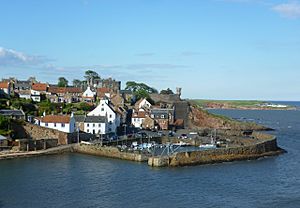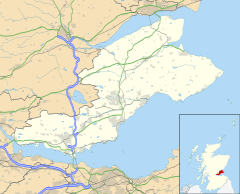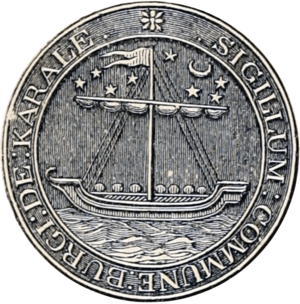Crail facts for kids
Quick facts for kids Crail
|
|
|---|---|
 |
|
| Population | 1,640 (2020) |
| OS grid reference | NO613078 |
| Council area | |
| Lieutenancy area | |
| Country | Scotland |
| Sovereign state | United Kingdom |
| Post town | ANSTRUTHER. |
| Postcode district | KY10 |
| Dialling code | 01333 |
| Police | Fife |
| Fire | Fife |
| Ambulance | Scottish |
| EU Parliament | Scotland |
| UK Parliament |
|
| Scottish Parliament | |
Crail is a historic town located in the beautiful East Neuk of Fife, Scotland. It used to be a "royal burgh," which means it had special rights given by the king. Today, it's a popular place with a charming harbour and a rich past. About 1,630 people live in Crail.
Contents
What Does the Name Crail Mean?
The name Crail has been around for a long time. In 1148, it was called Cherel. The first part of the name, Crail, comes from an old word meaning "fort." The second part might mean "rocks." So, Crail could mean "fort on the rocks."
A Look Back at Crail's History
Crail has a very long history, with signs of people living there for many centuries.
Early Religious Connections
The land where Crail's main church stands has been important for religious reasons since at least the 8th century. An old stone cross from that time can still be seen in the church today. The church itself was named after a holy person called St. Maelrubha in the 13th century.
Crail Castle and Royal Visits
Crail Castle was once a place where King David I of Scotland sometimes stayed in the 1100s. Over time, the castle fell into ruins. Crail became a royal burgh in 1178, during the rule of King William the Lion. This special status meant the town had certain freedoms and rights. Later, Robert the Bruce even allowed Crail to hold markets on Sundays.
Famous Visitors and Changes
In 1538, Mary of Guise, who would later marry King James V of Scotland, landed in Crail after a big storm. She was welcomed at Balcomie Castle before going to St. Andrews.
In 1559, John Knox, a famous Scottish reformer, gave a powerful speech in Crail Parish Church. After his sermon, people in the town removed religious images from the church. This was part of a big change in religious beliefs happening across Scotland at the time.
Later, in 1583, some Crail residents had a disagreement with a nearby landowner. They believed he had built new ditches on land that belonged to the community. They protested by filling in the ditches and destroying some trees. The Scottish government eventually told them to rebuild the ditches.
Crail's Coat of Arms
In 2017, the town's community council got back the official Coat of Arms for Crail. This special symbol had been lost when the old town council was removed in 1976.
Crail's Interesting Buildings
Crail has many old and beautiful buildings that tell stories of its past.
The Parish Church
The most important building in Crail is the parish church, located in the Marketgate. It was built in the late 1100s. For a long time, it belonged to a group of nuns. Today, it is known simply as Crail Parish Church. The churchyard also has a special gate built in 1921 to remember those who served in wars.
The Crail Tolbooth
The Crail Tolbooth is another famous building. It stands in the middle of the old marketplace, where Sunday markets used to be held. A "tolbooth" was like an old town hall and sometimes a jail. Crail's tolbooth has a unique tower from around 1600. Its roof looks a bit like buildings you might see in Holland. Look closely at the weathervane on top: it's shaped like a smoked haddock, which locals call a Crail Capon, instead of a rooster!
Crail Museum and Heritage Centre
Near the tolbooth, you'll find the Crail Museum and Heritage Centre. It's run by volunteers and is open every day in summer. The museum has changing exhibits and a permanent display about RNAS Crail, which was a naval air station nearby.
The Golf Hotel
The Golf Hotel on High Street is a very old building. It dates back to the 1700s or even earlier. It is considered a very important historical building.
Crail Harbour: A Busy Port
Crail's harbour has been important for centuries.
Building the Piers
In 1610, the eastern pier (a wall built into the water) was described as "newly built." However, by 1707, it was old and needed to be rebuilt. The western pier was rebuilt in 1828 by Robert Stevenson, a famous engineer. This pier still has a crane that lifts large wooden beams to close off the inner harbour.
Unique Stonework
If you look closely at the inner walls of the harbour, you'll see something unusual. The stones are placed vertically, which is a very rare way to build.
Famous People from Crail
Many interesting people have connections to Crail:
- Andrew Duncan (c.1560–1626) – A minister who was sent away for disagreeing with the king.
- James Sharp (1618–1679) – He became an important church leader, the Archbishop of St Andrews.
- James Oswald (1710–1769) – A talented composer.
- William Dickson (1866–1910) – A professional football player.
- Oswald Wynd (1913–1998) – A well-known author.
- Joan Clarke (1917–1996) – A brilliant code-breaker who worked with Alan Turing during World War II.
Ancient Fossils on the Beach
If you visit the beach near Crail harbour, you can find something amazing: fossilized trees! These fossils are related to modern Horsetails and are incredibly old, dating back to the Carboniferous period. That's millions of years ago!
Sport in Crail
Crail is home to the Crail Golfing Society, which is one of the oldest golf clubs in the world. It was started in 1786. Their oldest golf course, Balcomie, was officially designed by Tom Morris Sr. in 1894. However, golf competitions had been played there since the 1850s!
Gallery









